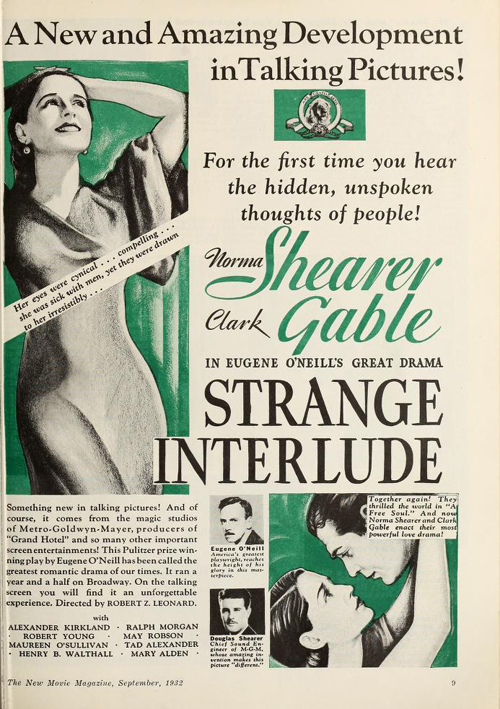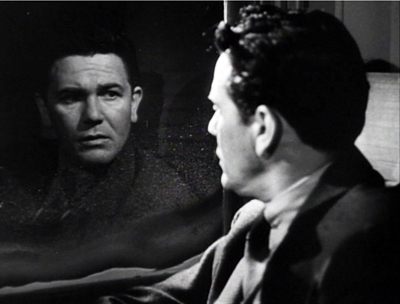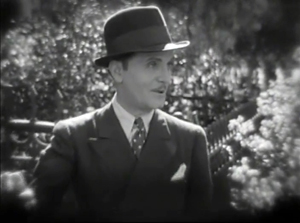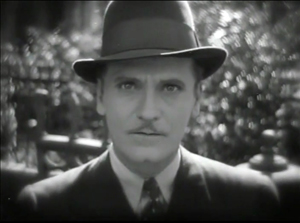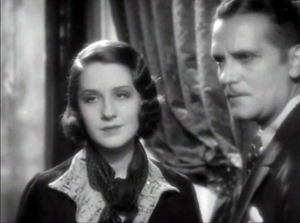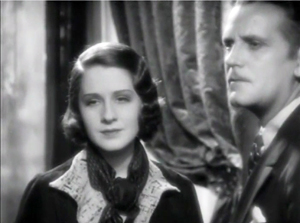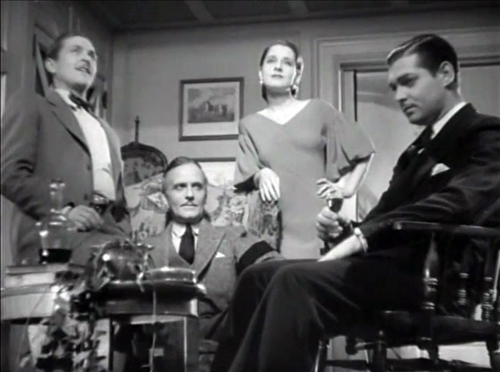DB here:
Seldom can we point to a moment when a movie convention is born. When, exactly, did crosscutting for suspense start? (Not, apparently, with Griffith.) What was the dissolve first used to convey the passage of time? What film first updated us on story developments by whipping newspaper headlines up to the camera?
We’re rightly discouraged from asking such questions. For one thing, we probably can’t answer them; too many films are lost. And what may matter is not the first time a technique is used but the process by which it becomes normalized and widespread. That’s when it achieves significance in the history of film forms.
Still, occasionally we might be able to pinpoint a crystallizing moment, when the convention assumes a distinct identity. The problem then becomes tracing the uptake, the process that makes the convention standardized enough to be understood by audiences.
In working on Hollywood narrative conventions of the 1940s, I’m drawn to moments in earlier decades when certain storytelling devices seem to emerge, although maybe only in partial or bastardized or confused forms. Here’s an example.
We don’t usually look to the MGM of this period as a hotbed of innovation. We think of it as the star-glutted studio that under Irving Thalberg turned out plump, well-upholstered productions of classics like David Copperfield (1935) and Romeo and Juliet (1937). Yet the search for prestigious productions led two releases of 1932 to become benchmarks of cinematic storytelling. Those two films launched conventions that are still with us.
The one I’ll consider today involves voice-over sound. I’ll examine a second one in a later entry.
The voice within
The Fallen Sparrow (1943).
Like most terms of craft, voice-over has several meanings.
In one usage, voice-over is what we hear when a narrator recounts information during a flow of images. An external, voice-of-God commentary like that opening The Roaring Twenties (1939) is one example.
Or a character in the story may be recounting what happened in the past. As we see a flashback, we hear the voice of the character in the present. Perhaps the character is talking with another character, or writing a letter or diary entry.
In each of these conventions, the voice-over sound isn’t coming from the action onscreen. We don’t see a source in the scene, and typically we don’t see the external narrator speaking, or the character who is hosting the flashback. Moreover, the sound has a different timbre; it’s miked more closely and without ambient effects. Another cue that the voice is “over” rather than “in” the images is the choice of verb tense. In a flashback, a character narrator will use the past tense to describe the action we’re seeing, and usually an impersonal narrator will as well.
There’s another type of voice-over, though. Here the voice is not sensed as “over” the action but “in” it. The voice is representing a character’s thoughts at the moment. The cues for this are likewise pretty clear and redundant. Again the voice is closely miked. It accompanies a medium or close shot of a character, and the words are spoken by the character’s own voice. But the character’s lips aren’t moving.
We understand that the sound represents the thoughts in the character’s mind. Using the literary term, we can call this convention interior monologue. Unlike voice-over commentary, the interior monologue is marked by the present tense. The character will refer to himself or herself with the pronouns “I” or “you.” In the sense I mean, the character isn’t a narrator; the character’s thoughts are what is narrated, by the convention I’ve picked out.
Both conventions of voice-over are strongly associated with Hollywood cinema of the 1940s. Call Northside 777 (1948) opens with the external narration of a detached, documentary-style voice.
In the year 1871, the Great Fire nearly destroyed Chicago. But out of the ashes of that catastrophe rose a new Chicago. A city of brick and brawn, concrete and guts, with a short history of violence beating in its pulse.
The narrator goes on to describe a crime that took place in 1932.
The Fallen Sparrow (1943), by contrast, starts in a train compartment, with Kit McKitrick opening his suitcase, taking out his gun, and looking out the window. As the train goes into a tunnel, the windowpane becomes a mirror, as above.
Over this image we hear Kit’s inner monologue.
All right. Go on. Let’s have it. Can you go through with it? Have you got the guts for it? Or did they knock it out of you? Made you yellow?
The screenplay’s indications are as follows: “Kit stares at the reflection of his own eyes. Softly, barely audible over this, though Kit’s lips do not move:…” There follows a slightly longer version of the voice-over text.
The inner monologue is a venerable literary technique, used in novels for decades, and plays for centuries as the soliloquy and the aside. So you’d think that early American sound filmmakers would have adapted it quickly and without fuss. Actually, they don’t seem to have done so.
You can find auditory flashbacks (another device some would call voice-over). In City Streets (1931) while Nan stands by the bars of her cell we hear a fragment of an earlier conversation. To venture outside Hollywood, there’s the famous example from Hitchcock’s Blackmail (1929) in which the heroine seems to hear “Knife!” emerge from casual breakfast talk with increasing volume. Here, I’d suggest, we’re getting an impressionistic filtering and exaggeration of a word that’s repeated in the action of the scene. Both passages are subjective, but neither is an interior monologue. And both are rare examples in early sound cinema.
Hence the interest of Strange Interlude, which MGM made in the spring of 1932.
Thinking out loud (very)
It’s based on a 1928 play that won Eugene O’Neill his third Pulitzer Prize. Like many of O’Neill’s projects, the drama was massive and experimental. It consists of nine acts lasting five hours, with a dinner break after the fifth act. The production was surprisingly successful, running over a year on Broadway and touring to packed houses around the US.
The action seems fairly skimpy for such a long play. At the start, Nina Leeds is grieving over the wartime death of her beloved Gordon. An older friend of the family, Charles Marsden, is secretly in love with her. Nina plunges into nursing work at a veterans’ hospital, and a doctor there, Ned Darrell, is concerned about her careless promiscuity. Darrell himself is attracted to Nina but resists falling in love with her. Instead he suggests that she consider marrying Sam Evans, a bright but good-hearted college boy she’s seeing.
She does, but she learns from Sam’s mother that there is a strain of madness in the family, and if they have a child, the lunacy is likely to be passed along. The mother brazenly suggests that Nina find a new partner and pretend the love child is Sam’s. The target father becomes Dr. Ned, and of course he and Nina fall in love.
The sexy situation surely drew notice; there were censorship rows in some cities. In addition, the play’s undertones attracted an audience who was starting to hear about Freudian theory. The men are all displacements and substitutes for Gordon; Nina even names her son for her dead sweetheart. At the end, when Nina relaxes in Charlie’s arms, she confusedly calls him “Father,” which is all an up-to-date 1920s intellectual needed to hear.
The formal innovations of Strange Interlude stem from what some critics considered O’Neill’s urge to create a “novelistic” drama. This explains not only the play’s extreme length, but its span of over two decades. Years pass between acts. O’Neill sought, he claimed at the time, to trace the complete history of a woman’s life, in a way that would show facets of the “Eternal Woman”: innocence, passionate youth, early marriage, infidelity, motherhood, and eventual acceptance of old age.
Another facet of O’Neill’s “novelistic” ambitions was the expansion of the old-fashioned theatrical aside into a string of inner monologues. A character speaks his or her thoughts aloud, and while the other characters can’t hear them, we can. All the major characters are given at least one passage of inner monologue. A great many of these run very long, over a page in the play script, and they were largely responsible for the vast length of the show.
Like a novel, the play gives us omniscience, gaining access to several characters’ minds. The thematic thrust of the device was that we often think things that are the opposite of what we say. We wear “verbal masks.” The inner monologues tell us about the characters’ real thoughts, and these tumble together in contradictions and associations. Here’s a short example from the first scene, when Nina’s father complains to Charlie that Nina has become a brittle young thing.
PROFESSOR LEEDS (absent-mindedly). Yes.
(Arguing with himself.) Shall I tell him? …no…it might sound silly…but it’s terrible to be so alone in this…if Nina’s mother had lived…my wife…dead!…and for a time I actually felt released!…wife!…helpmate…now I need help!…no use!…she’s gone!…
This passage is tame compared to the fleeting feelings and contradictory attitudes that scamper through Nina’s monologues. The effect is to suggest characters whose surface politeness conceals both shameful secrets and volcanic feelings.
As you’d imagine, there were problem making these interludes work onstage. The solution hit upon was to have the silent characters freeze in place while the “thinking” character delivered the monologue and moved freely around the set. The difficulties were compounded when O’Neill packed a series of monologues close together; at some moments, characters’ monologues seem to reply to each other. The choreography of the first productions must have been something quite dazzling and may account for the play’s success with audiences.
On the track of monologue
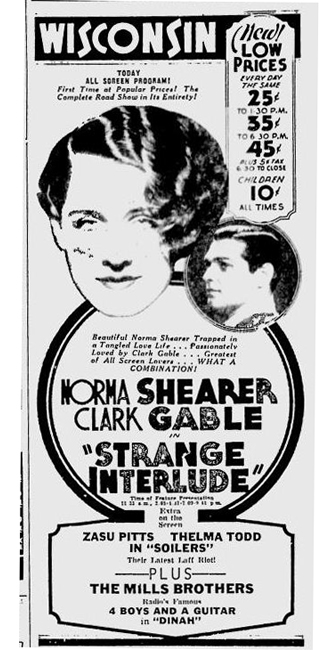 [3]Strange Interlude was one of several Broadway properties bought by Irving Thalberg and his story editor Samuel Marx. There were censorship constraints, so that Nina is no longer promiscuous and doesn’t abort her and Sam’s child. Still, in the film she does bear Ned’s child, and they mislead Sam into believing he’s the father. The plot is propelled by the lovers’ reunions at long intervals and their hesitation about revealing their secret to Sam, to Charlie, and to the grown-up Gordon. They rekindle their passion but decide not to run off or tell Sam the truth. If Nina is punished at the end, it’s because she’s never able to join Ned as his life partner.
[3]Strange Interlude was one of several Broadway properties bought by Irving Thalberg and his story editor Samuel Marx. There were censorship constraints, so that Nina is no longer promiscuous and doesn’t abort her and Sam’s child. Still, in the film she does bear Ned’s child, and they mislead Sam into believing he’s the father. The plot is propelled by the lovers’ reunions at long intervals and their hesitation about revealing their secret to Sam, to Charlie, and to the grown-up Gordon. They rekindle their passion but decide not to run off or tell Sam the truth. If Nina is punished at the end, it’s because she’s never able to join Ned as his life partner.
The script cuts the action down to fit a 112-minute running time, largely by dropping or condensing monologues. Very long speeches in the play become two or three lines in the film. There remained the question of how to present the monologues on film. In the early talkie days, people weren’t certain what to do.
MGM publicized the menu of options being considered. Director Robert Z. Leonard largely rejected the play’s tactic, that of having the thinking character turn slightly to the audience and speak in a different tone of voice. For a time, the production team thought of using superimpositions. A ghostly double of one character would appear at the proper moment and utter the thoughts while the tangible character stayed silent. Alternatively, Leonard considered having the ghostly doubles entirely replace the actors during the monologues. Given the pace at which the monologues bounce around the scene, the superimpositions would have been throbbing in and out pretty often.
The solution was the one that’s obvious to us. We simply see the thinking character and hear his or her thoughts, more closely miked, while the actor’s lips don’t move. Why did Leonard and his colleagues even consider other options? Partly because rerecording was not yet established as reliable enough to allow inserting lines, some mere interjections, into the flow of the recorded dialogue.
In production, the problem was solved in a mind-boggling way. The film was shot twice. The first go-round recorded the entire text, dialogue and monologue, for each scene. The dialogue was timed to fractions of a second. Then the monologue portions were transferred to phonograph discs. Then the film was rehearsed and re-shot, with the discs used as playback guides for the actors’ pauses. And the playback was recorded on the set, with the dialogue.
When the film was finally cut, the cleanly recorded monologues from the first go-round were cut into the shots of the actors thinking. They were amplified and, I think, spruced up a little in mixing to yield a more intimate sound field. Often they’re whispered, or at least delivered in a subdued tone.
Today the technique looks fairly conventional, at least at any given moment. At the time it seems to have struck observers as a novelty. “It is a technique admirably suited to the audible screen,” remarked the New York Times critic, musing, “I wonder whether these spoken private thoughts will inspire another picture with them?” Variety mocked Strange Interlude as a critic’s picture, a natural for “discourses on academic analyses of the contemporary ‘art of the cinema.’”
Both opinions strike most of us as deeply wrong. Today Strange Interlude looks a misbegotten monster, opposed to nearly everything we would celebrate about Hollywood sound cinema. Just when films were starting to pick up the pace, this movie goes lugubrious. Perhaps in the theatre O’Neill’s monologues wrap the action in a rhetorical micro-dramas, but in the film they expose the plot as a relentless tango of bourgeois self-absorption. The monologues drain the film of curiosity, suspense, surprise, and affect. There is no mystery in it. Everything is said, every question answered in advance. It must be one of the most absolutely explicit films ever made.
Yet if we argue that poor works of art can have worthy historical influence, I’d submit Strange Interlude as Exhibit A. Its purpose was misguided, and it bungled achieving even that, but it threw up an important convention that would eventually enhance cinematic storytelling.
Keep it to yourself, and to us
As a novelty, the filmic inner monologue ran risks. The Los Angeles Times critic worried that the movie version could confuse people who hadn’t seen the play. The ballyhoo for the release talked it up as “the first to pioneer in a new field of the talkie; namely, the presentation on the screen of hidden thoughts as well as the regular spoken dialogue.”
To assist viewers with the convention, the film has a foreword implying that we won’t see lip movements.
In order for us fully to understand his characters, Eugene O’Neill allows them to express their thoughts aloud. As in life, these thoughts are quite different from the words that pass their lips.
The opening scene immediately reinforces the point. Charlie walks down the street, greeting a one-legged soldier. This reassures us by displaying normal dialogue.
Charlie comes to the camera and pauses at the gate, musing aloud, “This pleasant old town, dozing. What memories it brings back.”
Then we get the film’s first inner monologue. His voice clear, his mouth closed, Charlie eyeballs the camera in a confiding way no one else will in the film. “Queer things, thoughts. Our true selves! Spoken words are just a mask to disguise them.”
The device is bared. It has been sharply contrasted with external dialogue and spoken monologue, and the theme of hidden thoughts is blatantly announced. Soon enough, after embracing Nina, Charlie’s voice-over reminds us: “How she’d laugh if she could only read my thoughts.” In the film’s first moments, its unusual sound device is flagged with Hollywood’s customary redundancy.
Throughout the film, Charlie is the only character who will occasionally play to the camera, in an echo of the stage production. The gesture reflects his role as an ineffectual observer of the Nina-Sam-Darrell triangle. In the film’s first sequence, which corresponds to the play’s first act, Charlie is also a crucial force for exposition, getting the lion’s share of inner speeches. In earlier plans for the play, he was intended as a chorus or stage manager.
So the film introduces its narrational device very explicitly. But as a film it offers a chance to coordinate the dialogues more tightly than was possible on the stage. With one character speaking while the others freeze, there was an inevitable slackening of pace. The movie camera, however, can isolate the thinking character. We can’t see what the offscreen characters are doing, so often they more or less cease to exist during the monologues. Concentrating on one character, we forget the others.
Probably O’Neill intended the fragmentary quality of some of the monologues as an equivalent of the stream-of-consciousness technique that Joyce had brought to literature with Ulysses in 1922. But by linking voices in a fairly linear way, Strange Interlude achieves the effect of an older novel in the Balzac-Dickens-Tolstoy line. In these works the omniscient literary narration shifts among characters within a scene. The film firms up this sense of gliding from mind to mind by isolating characters in singles, cueing us to expect a monologue at any moment. Sometimes, however, the film dares to interweave its dialogues and monologues within a sustained shot. At one point an aside from Nina in a two-shot is echoed by one from Charlie; she passes the ball by lowering her eyes, while he lifts his head.
The interpolations become quite fast and precise, as you can see from this extract.
It seems to me that film uses the technique more judiciously than the play does. After Charlie’s ruminations have provided exposition, Nina and Ned, the furtive lovers, get most of the monologues. Occasionally the drama adds new characters, such as Sam’s mother and the little boy Gordon, who seems to intuit Nina’s guilty thoughts. The film stages some climaxes as a ping-pong game of monologues, often without the cushioning of dialogue bits.
Here the characters seem to be conducting telepathic conversations.
But enough about me
Today the inner-monologue technique in Strange Interlude seems at once familiar and peculiar. I think that’s because the convention, in both fiction and film, didn’t develop along the choral lines the play and film laid down.
Today novelists are advised to stick to only one point-of-view character per scene. A current manual warns: “If you simply jump from head to head as the mood strikes you, the voice becomes a fractured mess.” Manuals of O’Neill’s time gave the same advice. Critic Clayton Hamilton admitted that a viewpoint could shift from scene to scene or chapter to chapter (the so-called “limited omniscience” technique) but he stressed that within a scene, the author should stick to rendering only one character’s viewpoint.
This is what we have come to expect in mainstream cinema. Not only inner monologues but all channels of subjectively tinted information are usually slanted toward one character per scene. So a film might have several point-of-view characters in its overall running time (e.g., Psycho), but any given scene is likely to be anchored around one.
When inner monologue doesn’t do this, comedy can result. Cuddling on a sofa in Me and My Gal (1932), Danny and Helen discuss a picture he remembers as “Strange Innertube.”
Ten years later, in A Yank on the Burma Road, the same gimmick was yielding flat-footed comedy.
Perhaps because it seemed a bit silly, very few 1930s filmmakers seem to have picked up the inner monologue device for serious drama. When they did, the multi-voiced version seems more common. In The Life of Vergie Winters (1933), the main characters attend a political rally, and each one gets a bit of interiority.
Thornton Wilder’s play Our Town (1938) not only presented a commenting narrator in the form of a stage manager, but included a scene of a wedding ceremony that assembled thoughts issuing from the minister (played by the Stage Manager) and the bride’s mother. For the 1940 film version, other characters’ inner monologues were added.
Both Vergie Winters and the Our Town film also include moments focused on a single character’s inner monologue. Still, it’s remarkable how few films of the 1930s pick up on device at all. I speculate that storytellers became more comfortable with it as it became more common on radio late in the decade. The strategy was emphasized by Orson Welles and especially Arch Oboler. By 1939 Oboler was building entire plays out of what he called “stream of consciousness” technique. Soon the inner monologue as we know it started to be heard in talk-filled films like Angels over Broadway (1940) and noirish tales like The Stranger on the Third Floor (1940).
Perhaps it took radio to teach filmmakers the dramatic power of the inner monologue. It was certainly suited to many genres, from crime and suspense stories to melodrama and even comedies. Since it crystallized in the 1940s, the technique, while rare, has never really gone away. Ingenious filmmakers, from Resnais to Wong Kar-wai, have revived and revised it.
More generally, I suspect we should thank radio and the stage, including plays as ungainly as Strange Interlude, for urging filmmakers to try for more. These models pushed narration beyond the momentary shove and tug of character-in-a-situation and overlaid a speaking voice that undertook the task of remembrance, commentary, and confession. Novelistic cinema, of a certain kind, was launched.
A later entry will consider another convention launched by an MGM movie in 1932. But you have probably figured out what that is.
A big thank-you to Michele Hilmes and Shawn Vancour for helpful guidance in the literature of radio. I’ve also learned from Neil Verma’s Theatre of the Mind: Imagination, Aesthetics, and American Radio Drama (University of Chicago Press, 2012). Thanks as well to Kat Spring and Luke Holmaas for suggestions on 1930s sound.
On the staging of the play, see Philip Moeller, “Drama Makes Regular Stops,” Los Angeles Times (17 March 1929), C14. O’Neill’s novelistic intentions are discussed in “Origin of Drama Traced,” Los Angeles Times (3 March 1929), C16-C17.
I mention Ulysses as an influence, but surely O’Neill read Virginia Woolf, Ford Madox Ford, and other modernists too. The idea of a split-vocalizing character was explored in earlier avant-garde drama. One precedent which O’Neill might have known is the “monodrama” of Nikolay Evreinov. Eisenstein points out the parallel in his memoirs (Beyond the Stars, BFI/ Seagull, 1995), 521. (Thanks to Yuri Tsivian for the lead.) Joseph Wood Krutch defends the play’s novelistic introspection in The Nation (15 February 1928), 192. In all, Strange Interlude strikes me as an amalgam of the older novelistic tradition with the emerging stream-of-consciousness technique. Some, probably including me, would call the play a piece of middlebrow modernism.
On the making of the film, see “Filming ‘Interlude,’” New York Times (13 March 1932), X6 and Edwin Schallert, “Mute Stars to Speak Words,” Los Angeles Times (9 March 1932), 7. Lea Jacobs points out that re-recording practice in Hollywood faced problems of exact timing. Not until 1935, with the advent of “push-pull” tracks and click sheets, could filmmakers control in postproduction the tight interweaving of sources that Strange Interlude created through playback in production. See her Film Rhythm after Sound: Technology, Music, and Performance [9], discussed in an earlier entry [10]. On Thalberg’s strategy of buying Broadway hits, see Mark A. Vieira’s Irving Thalberg: Boy Wonder to Producer Prince [11] (University of California Press, 2010), 161-198.
The New York Times critic Mordaunt Hall reflected on the inner-monologue technique in “At the First Night of a Worthy Film” (11 September 1932), X3 and “The Screen: Eugene O’Neill’s ‘Strange Interlude’ Is Engrossing and Compact in Film Form” (1 September 1932), 24. The ballyhoo mentioned comes from Sid Grauman, who claimed he was going to embed a print of the movie into a wall niche of his theatre as a permanent memorial. See “‘Interlude’ Print to Be Sealed in Theater,” Los Angeles Times (23 July 1932), A7. The Variety review comes from 6 September 1932, 15.
The inner monologue is one type of what we call in Film Art “internal diegetic sound.”
Loyal Marxians will recall Groucho’s address to the audience [12] in Animal Crackers (1930): “Pardon me while I have a strange interlude.”
Arch Oboler employs “stream-of-consciousness” in some of his 14 Radio Plays [13] (Random House, 1940); his glossary explains the device as “Thoughts in the mind of character; method of delivery should be quiet, semi-monotone, with far less coloring than ‘conscious’ speeches” (257). The definition would cover flashbacks, but clearly some of Oboler’s 1939 plays such as Baby and The Ugliest Man in the World use the inner monologue. The former is printed in 14 Radio Plays, and the script of latter is available here [14]. Go here [15] to listen to both.
It seems clear that critics’ demand that viewpoint be restricted for an individual scene, however much it may shift between scenes, stems from the influence of Henry James. James argued for the unity and power of a limited point of view, often conceived as “seeing” the action from a certain character’s “vantage point.” “There is no economy of treatment without an adopted, a related point of view,” he writes in the preface to The Wings of the Dove [16]. “I understand no breaking up of the register, no sacrifice of the recording consistency, that doesn’t rather scatter and weaken.”
What Joseph Warren Beach called “the well-made novel” trend that followed James placed great emphasis on this economy. See Beach’s neglected but astute The Twentieth Century Novel: Studies in Technique [17] (Appleton Century Crofts, 1932). My paraphrase of Clayton Hamilton comes from Materials and Methods of Fiction [18] (Doubleday Page, 1917), 1228-129. The contemporary advice I quote is in Sandra Newman and Howard Mittelmark, How Not to Write a Novel [19] (Penguin, 2008), 164.
A bold use of O’Neill’s abruptly spliced monologues comes from a different author named James. In one scene of her detective novel Cover Her Face, the late P. D. James gathers several suspects waiting to be questioned. “All of them sat in essential isolation and thought their own thoughts.” James’ third-person narration is omniscient with a vengeance, leaping from mind to mind, quoting the thoughts in parallel blocks. The force of the scene comes not only from the jumps in viewpoint but also from the way they violate a cardinal convention of detective stories. The culprit, we have been told, “must not be anyone whose thoughts the reader has been permitted to follow.” Do James’ plunges into interiority clear these people of suspicion? The formulation comes from Ronald A. Knox, “A Detective Story Decalogue,” in Howard Haycraft, ed., The Art of the Mystery Story [20] (Grosset and Dunlap, 1947), 194. Of course this rule applies to the puzzle-oriented story in the Sherlock Holmes tradition, not the thriller or suspense tale. For more on the difference see my web essay “Murder Culture.” [21]
P.S. 22 March 2015: You never stop learning. I just discovered that George Meredith’s novel Rhoda Fleming (1888) contains a passage that prefigures, in all its awkwardness, the device of Strange Interlude, both play and movie. Rhoda and Robert are talking, and Meredith’s omniscient commentary shadows their lines with parenthetical indications of their thoughts. These mental interjections often contradict their spoken words.
“I’ve always thought that you were born to be a lady.” (You had that ambition, young madam.)
“That’s what I don’t understand.” (Your saying it, O my friend.)
“You will soon take to your new duties.” (You have small objection to them even now.)
“Yes, or my life won’t be worth much.” (Know, that you are driving me to it.)
“And I wish you happiness, Rhoda.” (You are madly imperilling the prospect thereof.)
And so on. This to-and-fro passage occurs in Chapter XLIII. And yes, the book isn’t called Rhonda Fleming, more’s the pity.
Strange Interlude.
